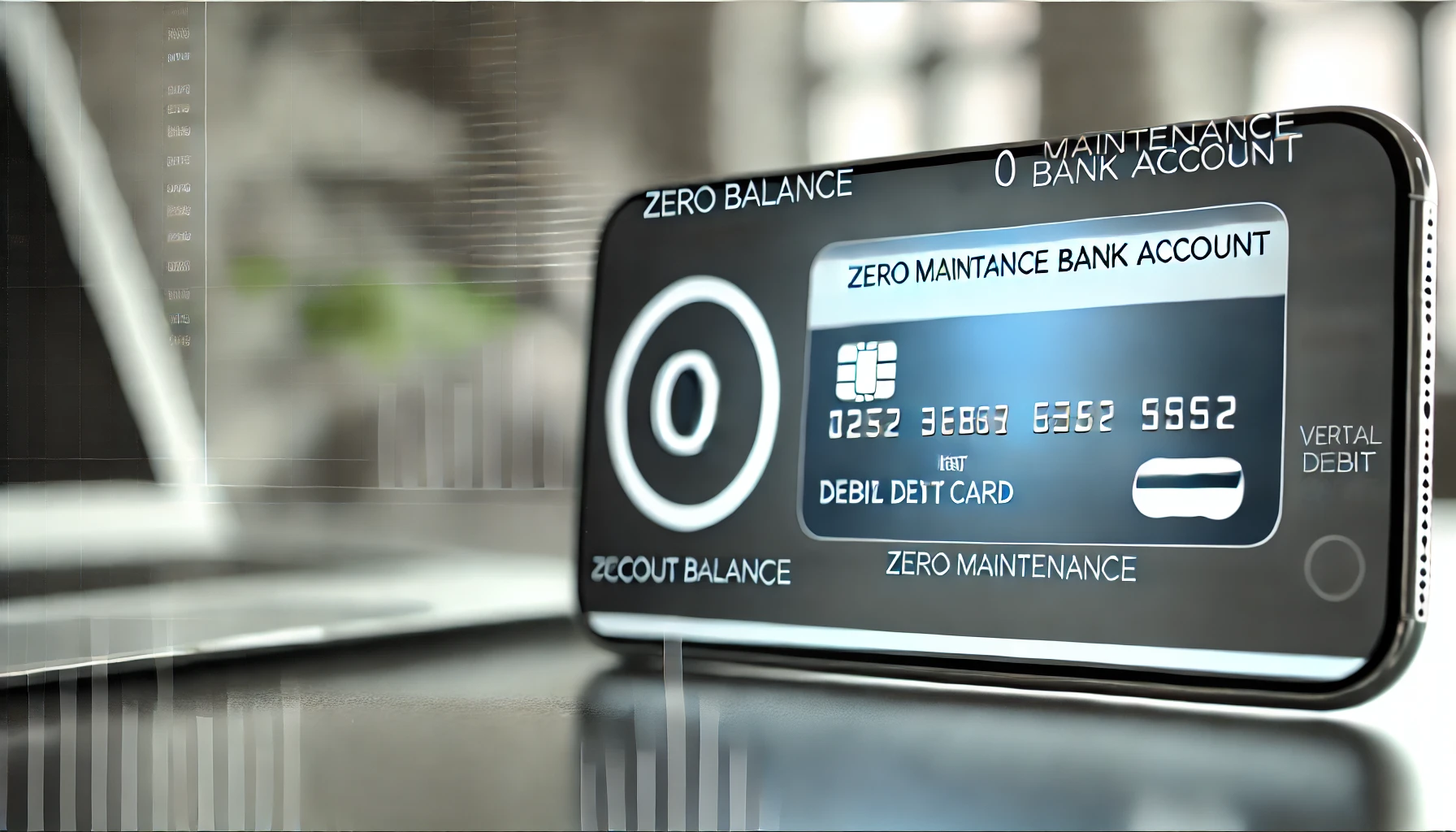In today’s fast-paced world, people want banking solutions that offer convenience without unnecessary charges. One of the most sought-after banking services is the zero maintenance bank account. These accounts allow you to manage your finances without the hassle of maintaining a minimum balance or facing penalties. In this blog, we will explore the features, benefits, and limitations of zero maintenance bank accounts, including a comprehensive overview of the best options available.
1. What is a Zero Maintenance Bank Account?
A zero maintenance bank account is an account that doesn’t require the account holder to maintain a minimum balance. These accounts come with basic banking features, making them ideal for individuals who want to manage their money without the worry of incurring charges due to low balances.
- Zero Account Meaning: The term “zero account” refers to an account where there is no requirement to maintain any minimum balance. This is especially useful for people with irregular incomes or those who prefer to keep their savings elsewhere.
2. Benefits of Zero Balance Accounts
The rise of zero balance accounts has offered several advantages to account holders:
- No Minimum Balance: The most significant benefit is that there is no need to maintain a specific amount in the account. This makes it highly accessible for individuals from various economic backgrounds.
- Free Virtual Debit Card: Many banks provide a zero balance account with virtual debit card access, allowing for seamless online shopping and fund transfers.
- No Maintenance Charges: A zero charge bank account typically doesn’t incur fees for account maintenance, making it a cost-effective solution.
3. Which Bank Gives Zero Balance Account?
Many banks offer zero balance accounts with varying features. The following is a list of banks with zero balance account offerings:
- SBI (State Bank of India): Offers a Basic Savings Bank Deposit Account (BSBDA), which allows zero balance with free ATM services.
- ICICI Bank: Their “Pockets” digital bank provides a zero maintenance bank account with a virtual debit card.
- HDFC Bank: Offers the Basic Savings Bank Deposit Account for customers who prefer to maintain zero balance.
- Axis Bank: Provides a zero balance account with virtual debit card for those looking for digital solutions.
4. Which Bank is Best for Zero Balance Account?
Choosing the best zero balance account depends on your needs. Here’s a quick comparison to help you decide:
- SBI: Best for traditional banking with a large ATM network across India.
- ICICI Bank: Ideal for tech-savvy users who want digital banking solutions, including virtual debit cards.
- HDFC Bank: Provides solid customer service with a range of financial products linked to the zero balance account.
- Axis Bank: Known for offering attractive interest rates and virtual banking facilities.
5. How to Open a Zero Balance Account
Opening a 0 balance account is easy and can be done both online and offline. Here is a step-by-step process for 0 balance account opening bank list:
- Step 1: Choose the bank that offers the best zero maintenance bank account according to your needs.
- Step 2: Visit the bank’s branch or go to their website for online account opening.
- Step 3: Fill out the application form and submit KYC documents such as proof of identity and address.
- Step 4: Once the bank verifies your details, your account will be activated, and you can access it through a virtual or physical debit card.
6. Zero Balance Account Limits
Although zero balance accounts come with numerous perks, they also have certain limitations, particularly in terms of transactions. Here are some typical restrictions:
- 0 Balance Account Limit: Some banks set transaction limits on zero balance accounts. For example, there may be a limit on the amount you can withdraw in a single day.
- Zero Balance Account Withdrawal Limit: Each bank has its own withdrawal limits. For example, you might be allowed to withdraw up to ₹50,000 per day from ATMs.
- Zero Balance Account Transaction Limit: While you can perform various transactions, some banks may restrict the number of free transactions you can carry out in a month.
7. Zero Balance Accounts with Additional Features
Some banks go beyond the basics and offer zero balance accounts with additional features:
- Virtual Debit Card: As mentioned earlier, some banks offer a zero balance account with virtual debit card, which allows you to make online transactions without needing a physical card.
- No Hidden Charges: Many banks are now offering zero charge bank accounts where there are no hidden fees for account maintenance or services.
8. List of Banks with Zero Balance Account Options
Here’s a zero balance account opening bank list that highlights the major players offering such accounts in India:
- State Bank of India (SBI)
- ICICI Bank
- HDFC Bank
- Axis Bank
- Kotak Mahindra Bank
- IndusInd Bank
- Yes Bank
- Bank of Baroda
- IDFC FIRST Bank
- Punjab National Bank (PNB)
These banks offer varying degrees of features, such as free debit cards, easy digital access, and lower transaction limits.
9. How to Apply for Converting Zero Balance Account to General Account
In case you want to convert your zero balance account into a regular savings account, follow these steps:
- Step 1: Visit your nearest branch or log into your net banking account.
- Step 2: Fill out the application for converting zero balance account to general account. Provide the necessary KYC documents, if required.
- Step 3: Once the application is approved, your account will be converted, and you may have to maintain a minimum balance.
10. What is the Zero Balance Account Limit?
The zero balance account limit varies by bank. For instance:
- Transaction Limit: Most banks cap the number of free ATM withdrawals at 5-10 per month. After that, additional fees may apply.
- Daily Withdrawal Limit: This limit may range between ₹25,000 and ₹1,00,000 depending on the bank and the account type.
11. Zero Maintenance and Zero Charge Bank Accounts
Many banks offer zero charge bank accounts, meaning there are no fees for services such as fund transfers, passbook updates, or account maintenance. This can be particularly useful for individuals looking to maximize their savings without worrying about deductions.
12. Zero Balance Account Transaction Limit
Each zero balance account has specific transaction limits, particularly for:
- Online Transfers: Some banks may limit the amount of funds you can transfer in a single day through UPI or NEFT.
- Cash Deposits/Withdrawals: There may also be limits on the number of cash deposits or withdrawals per month.
13. Zero Balance Accounts with Virtual Debit Cards
A few banks provide zero balance accounts with virtual debit cards that allow you to make secure online purchases. These cards are particularly useful for individuals who do not want to carry a physical card but need easy access to online banking and shopping.
14. Conclusion
A zero maintenance bank account is an excellent option for those looking for flexible, hassle-free banking. Whether you’re a student, freelancer, or someone with fluctuating income, the benefits of zero balance accounts far outweigh the minor limitations they may come with. With a wide range of options available from various banks, it’s essential to choose the one that best suits your financial needs. Evaluate factors such as zero balance account transaction limits, daily withdrawal limits, and the availability of a virtual debit card before making your decision.
By opting for a zero charge bank account, you can enjoy seamless banking without the worry of hidden charges or minimum balance requirements.

How much amount can be withdrawn from cheque
Cheques are a traditional yet effective way to withdraw money from your bank account. Whether …

Can I Get an ATM Card Before 18? A Comprehensive Guide
In today’s digital age, financial literacy and access to banking services are increasingly important for …

Zero Maintenance Bank Account: The Ultimate Guide
In today’s fast-paced world, people want banking solutions that offer convenience without unnecessary charges. One …

How to Convert a Salary Account to a Savings Account: A Step-by-Step Guide
A salary account is typically provided by your employer to deposit monthly salaries. It often …


















